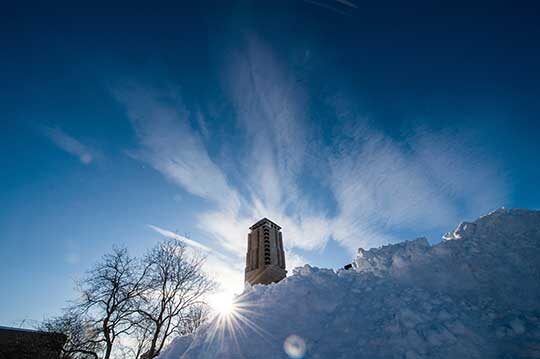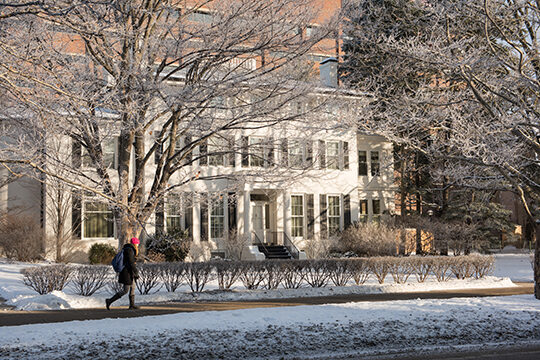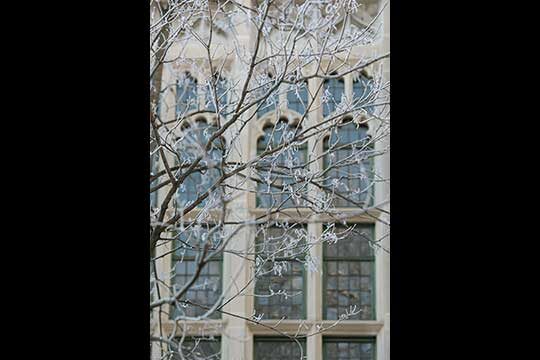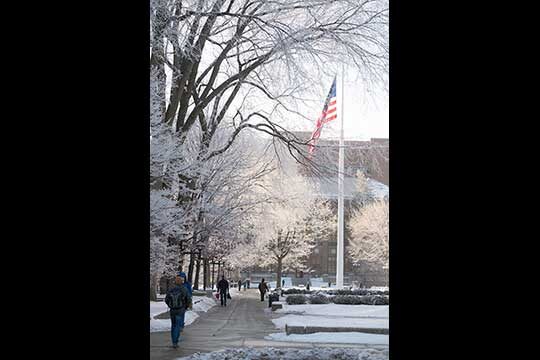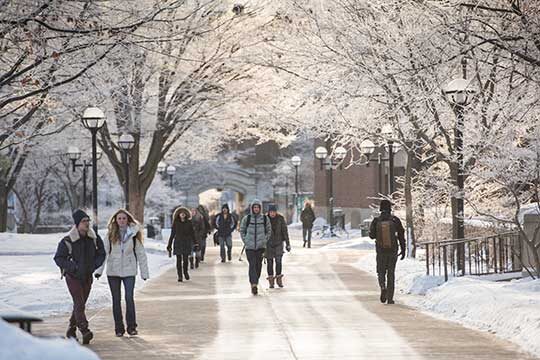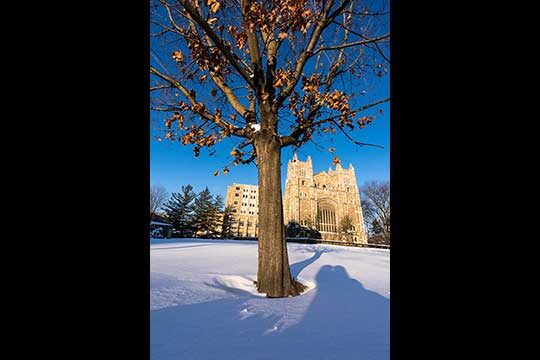Let it go
Things may be frozen on the Ann Arbor campus but one can still appreciate the breathtaking beauty of U-M on ice.
-
Clearly beautiful
The Lurie Tower on North Campus juts forth from a small “mountain” of snow, which actually is translucent, not white. It looks white because of the way the light reflects off ice crystals. (Source: Michigan Science Center. Photo: Austin Thomason, Michigan Photography.)
-
Anybody home?
White or painful fingers – and toes – mean your digits have already gotten so cold you’re in danger of frostbite. The time to get somewhere warm is when you start to feel that your fingers are getting cold. This lone student appears safe so far, but she can always knock on President Schlissel’s door if things grow dire. (Source: UofMHealthBlogs.org. Photo: Scott C. Soderberg, Michigan Photography.)
-
Exhibit A: Hoar frost
Under clear frosty nights in winter soft ice crystals might form on vegetation or any object that has been chilled below freezing point by radiation cooling. This deposit of ice crystals outside the Law School is known as “hoar frost” and may sometimes be so thick it might look like snow. (Source: weatheronline.co.uk. Photo: Scott C. Soderberg, Michigan Photography.)
-
Orange is the new black
Hoar frost might form as liquid dew that has subsequently frozen with a drop in temperature, which is then known as silver frost or white frost. Usually the dew drops do not freeze immediately, even if the air temperature is slightly below zero. Rather they become supercooled dew droplets at first. Supercooled dew will eventually freeze if the temperature falls below about 26 degrees. The same could be said for supercooled business students inside this Ross School building. (Source: weatheronline.co.uk. Photo: Scott C. Soderberg, Michigan Photography.)
-
Frosty
When hoar frost occurs, interlocking ice crystals become attached to branches of trees, leaves, hedges, and grass blades. This is one of the most prominent features of the classic “winter wonderland.” These fine “feathers,” “needles,” and “spines” also might be found on any other object that is exposed to supersaturated air below freezing temperature. (Source: weatheronline.co.uk. Photo: Eric Bronson, Michigan Photography.)
-
Six sides to every story
These students entering the Samuel T. Dana Building, home to the School of Natural Resources and Environment, surely know all snowflakes have six sides. Period. (Source: learner.org. Photo: Scott C. Soderberg, Michigan Photography.)
-
Rackham up
Every winter at least one septillion (that is 1,000,000,000,000,000,000,000,000) snow crystals fall from the sky. Ten inches of snow melts down to only one inch of water. (Source: Michigan Science Center. Photo: Austin Thomason, Michigan Photography.)
-
Now, for the good news…
Being outside in cold weather means your body has to work harder to keep your core temperature up, says U-M’s Brad Uren, MD, assistant professor of emergency medicine at the Medical School. Thus, your calorie intake should increase to compensate, though that’s not an excuse to break your New Year’s weight loss resolution. The air is drier too, so drinking fluids, especially water, is important. (Source: UofMHealthBlogs.org. Photo: Eric Bronson, Michigan Photography.)
-
Dedicated followers of fashion
Don’t let fashion lead to frostbite, warns Brad Uren, MD, assistant professor in the department of emergency medicine at the Medical School. “Everyone has their blind spot,” Uren says, “like wearing driving gloves to shovel or shoes that have no insulation. Cover up everything in a way that’s appropriate to what you’ll be doing outside.” This includes good footwear that will keep you upright when sidewalks start to freeze, and protect vulnerable toes. (Source: UofMHealthBlogs.org. Photo: Eric Bronson, Michigan Photography.)
-
This bites
One spot many folks forget to cover when outdoors in ultra-cold temperatures is the eyes – and the delicate skin around them can get frostbitten fast. Ski goggles and work goggles can cut the risk, and even regular eyeglasses offer some protection, says Brad Uren, MD, assistant professor in the department of emergency medicine at the Medical School. (Source: UofMHealthBlogs.org. Photo: Scott C. Soderberg, Michigan Photography.)
-
Snowbound at G.G. Brown
This new addition to the G.G. Brown Laboratory sparkles warmly in the early morning sun — but it’s still very cold outside! So if you have asthma or other breathing issues, take steps to keep ultra-cold air from affecting you, for instance with a scarf. If you take medicine for high blood pressure, or other conditions, ask your doctor or pharmacist if your prescription might make you more susceptible to cold or even frostbite – some can. If you take blood thinners, a simple fall on the ice can cause a lot more damage for you than for others. (Source: UofMHealthBlogs.org. Photo: Austin Thomason, Michigan Photography.)
-
Snow business
The New Yorker reports that since its release, the movie Frozen has earned more than $1.2 billion worldwide, becoming the fifth-highest-grossing film of all time and by far the highest-grossing animation. That’s not to mention two Academy Awards, a BAFTA, a Golden Globe, a soundtrack that’s garnered more than a million album sales and seven million Spotify streams, official YouTube video views in the hundreds of millions, and a DVD that became Amazon’s best-selling children’s film of all time based on advance orders alone. Sounds like a good case study for business students at the Stephen M. Ross building. (Photo: Daryl Marshke, Michigan Photography.)
-
Calm after the storm
Blizzards occur when visibility is less than a quarter mile, the winds are 35 miles per hour or more, and the storm lasts at least three hours. Anything less is considered a snowstorm. And this image of the Law School is just considered pretty. (Source: Michigan Science Center. Photo: Daryl Marshke, Michigan Photography.)

